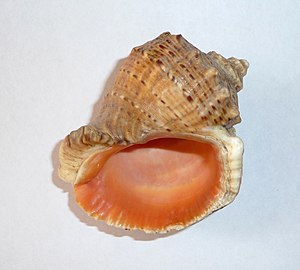Rapana
| Rapana | ||||||||||||
|---|---|---|---|---|---|---|---|---|---|---|---|---|

Casing of Rapana venosa |
||||||||||||
| Systematics | ||||||||||||
|
||||||||||||
| Scientific name | ||||||||||||
| Rapana | ||||||||||||
| HCF Schumacher , 1817 |
Rapana (from the Latin rapa = turnip) is a genus of predatory snails living in the seafrom the family of spiny snails . The four species arenative tothe Indian Ocean and the western Pacific to the Sea of Japan , but two species have been introduced to other regions worldwide by humans.
features
The large, up to 18 cm long snail shells of the Rapana species have a very large, oval, forwardly tapered housing mouth which ends in a short, open siphon channel, a bent, forwardly free inner lip and a wrinkled umbilicus. The thread is low and the whorls are edged. The housings have spiral ribs and axially extending fins. Often there are also hollow spines on the edges of the passageways. The horny operculum has a lateral core.
The snails of the genus Rapana are separate sexes with internal fertilization. The females lay clutches with numerous egg capsules, each containing several hundred eggs. After usually less than 4 weeks, Veliger larvae hatch and go through a month-long pelagic phase during which they feed on plankton. Eventually metamorphosis takes place on the sea floor and the small snails begin a life as carnivores . At the time of metamorphosis, their casing length is around 0.5 mm ( Rapana rapiformis ) or a good 1 mm ( Rapana venosa ). They can live for several years.
All Rapana species, like other porcupines, live predatory, mainly on mussels and snails . You can press your proboscis between the shell halves of a mussel or drill a hole in the shell with the radula .
species
The genus Rapana includes the following species:
- Rapana bezoar ( Linnaeus , 1767), native to the South China Sea , western Pacific and Indian Ocean , off Madagascar ;
- Rapana pellucida Bozzetti, 2008, native to southern Madagascar;
- Rapana rapiformis (Born, 1778), native to the East China Sea , South China Sea , in the Indian Ocean off Madagascar and on the coast of East Africa , introduced into the Mediterranean Sea;
- Rapana venosa ( Valenciennes , 1846), native to the Sea of Japan , Yellow Sea , Bohai Sea and East China Sea as far as Taiwan , introduced into various waters around the world.
Rapana bulbosa (Dillwyn, 1817) is a synonym of Rapana rapiformis .
Individual evidence
- ^ A b Heinrich Christian Friedrich Schumacher: Essai d'un nouveau système des habitations des vers testacés, avec XXII planches . Imprimerie de Mr. le directeur Schultz, Copenhague 1817. p. 214: Genre LVII. Rapane: overture oval, rétrécie par devant; le bec court, recourbé, le canal ouvert; la lèvre internal repliée, dégagée par devant; ombilic ridé. Rapana: apertura ovalis antice coarctata; rostrum breve, recurvum, canali aperto; labium internum replicatum, antice solutum; umbilicus rugosus .
- ↑ G. Thomas Watters, Ohio State University: Digital Murex - Rapana Schumacher, 1817 ( Memento of the original from July 19, 2010 in the Internet Archive ) Info: The archive link was inserted automatically and has not yet been checked. Please check the original and archive link according to the instructions and then remove this notice. .
- ↑ Juliana M. Harding (2006): Growth and development of veined rapa whelk Rapana venosa veligers (PDF; 245 kB) . Journal of Shellfish Research 25 (3), pp. 941-946.
- ^ A b Brian Morton: Prey preference and method of attack by Rapana bezoar (Gastropoda: Muricidae) from Hong Kong . In: Brian Morton (Ed.): The Malacofauna of Hong Kong and Southern China III . Proceedings of the Third International Workshop on the Malacofauna of Hong Kong and Southern china, Hong Kong, April 13-1 May 1992. Hong Kong University Press, Hong Kong 1994. pp. 307-325.
- ↑ a b World Register of Marine Species , Rapana Schumacher, 1817 and the linked pages on the four recognized species
literature
- Heinrich Christian Friedrich Schumacher : Essai d'un nouveau système des habitations des vers testacés. Genre 57, pp. 214, 1817 (first description)